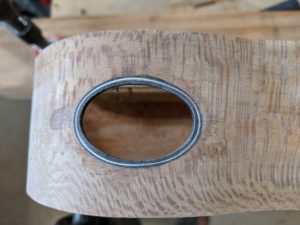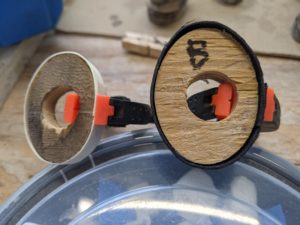I have found that a side sound port makes a real difference in the sound of an instrument. It kind of ‘opens up’ the instrument so it is brighter, louder, warmer, everything. Needless to say, most instruments I build these days have a side sound port unless it is declined by a commission.
I bind the edges of the port, which is after all, a hole cut in the side. I bind the edges with three layers of dyed veneer, usually black-white-black but I have done black-red-black to match black-red-black purfling. I used to pre-bend stripes of veneer (thin for the inner two layers and a thicker black outside layer) on a hot pipe, like bending other wood. This worked OK, but the bend was only an approximation of the oval shape of the sound port, and gluing them in required a certain amount of muscling things in, with the occasional cracked veneer.
I have gone to a new system. There are a number of veneer softeners on the market, with Super-Soft being popular. This stuff softens wood fibers, making the wood bendable. When things dry out it leaves no residue, no color change, it is as if it was never there and the wood holds the shape it was bent into.
So – I made some little ovals of plywood which match the oval of the sound hole. Bigger for baritones, smaller for tenors and concerts. I soak the veneer strips in Super-Soft for 5 minutes or so, and then the veneer is pliable enough to bend around the oval forms without cracking, even the thicker black outer layer. I clamp the ends, let things dry, and the oval shape is held very well. They go into the sound port when binding it with very little need for muscling things to fit. Easy, cheap, and works great.


